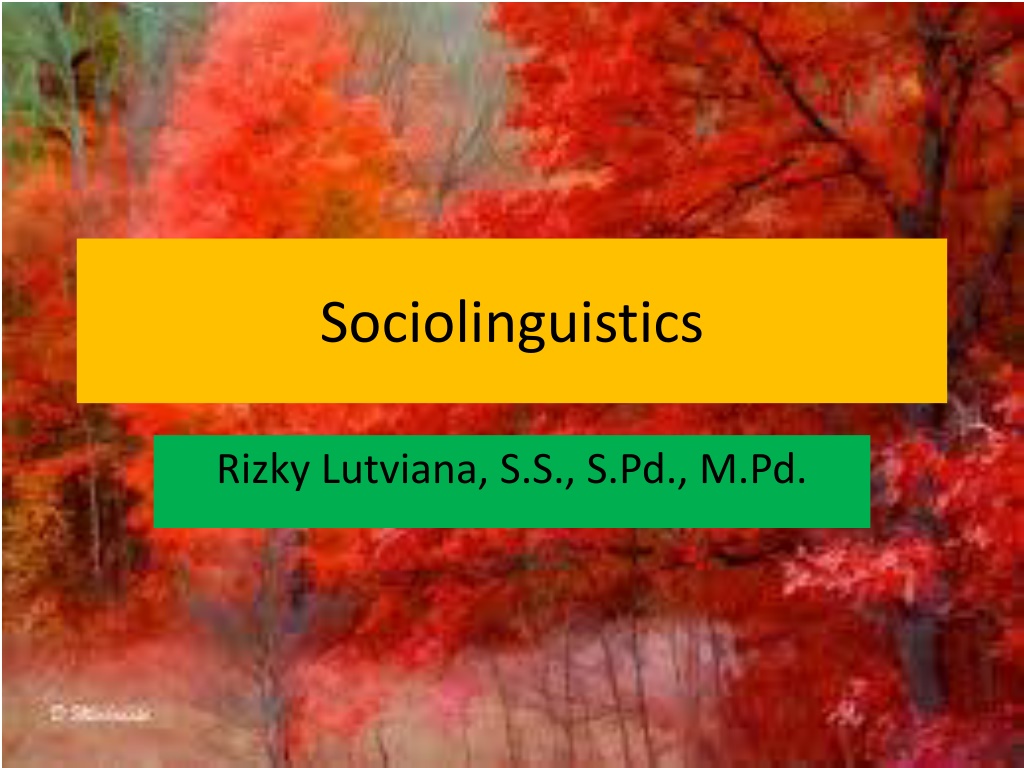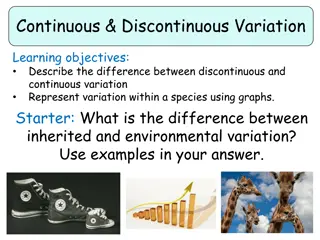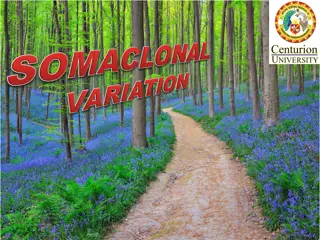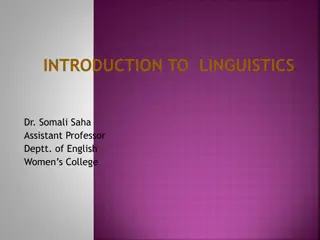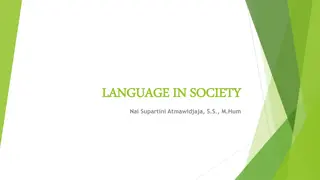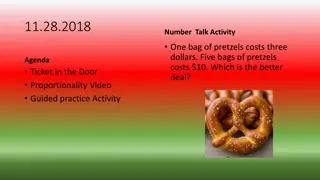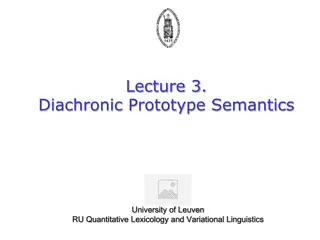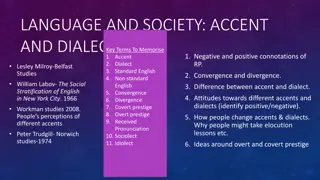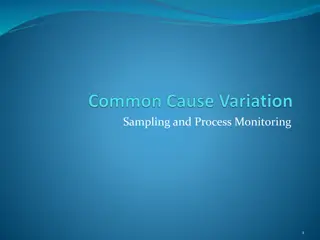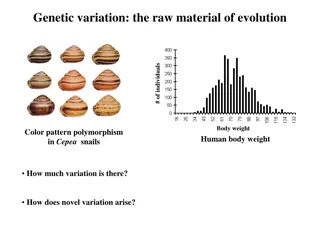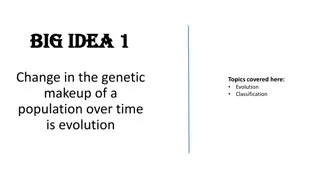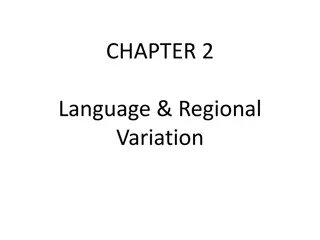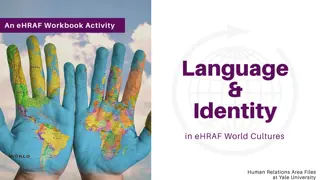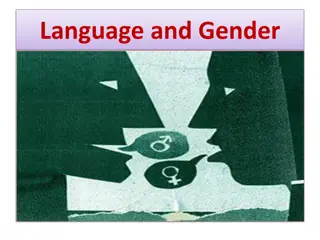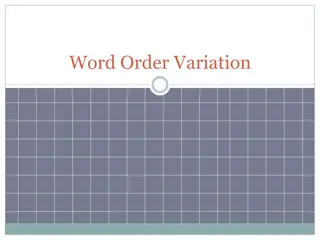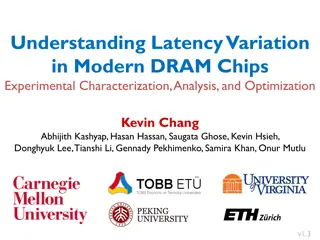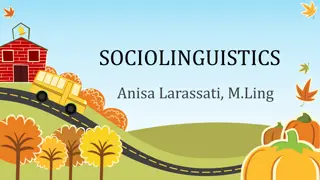Exploring Sociolinguistics: Language Variation and Social Factors
Sociolinguistics delves into the study of language variation influenced by social factors, examining the relationship between language and its social context. It explores various aspects like standard pronunciation, language choice, speech acts, language components, language variety, and factors such as gender and age in language usage. The discipline also investigates the role of social dimensions like status, formality, and functional aspects in communication. Understanding these dynamics is crucial for a comprehensive view of language and society.
Download Presentation

Please find below an Image/Link to download the presentation.
The content on the website is provided AS IS for your information and personal use only. It may not be sold, licensed, or shared on other websites without obtaining consent from the author. Download presentation by click this link. If you encounter any issues during the download, it is possible that the publisher has removed the file from their server.
E N D
Presentation Transcript
Sociolinguistics Rizky Lutviana, S.S., S.Pd., M.Pd.
CHAPTER 1 TERMINOLOGIES, FACTORS LANGUAGE CHOICE, & SOCIAL DIMENSION
What is sociolinguistics The study of language variation caused by social factors What do sociolinguistics study? Social function of language The relationship between language and context in which it is used Linguistics variation
ELT Sociolinguistics Standard pronunciation Teaching speaking Speech act Teaching language components Language variety Teaching reading and writing Code switching Strategy in teaching Gender and age factor
1. Health is a complete state of physical, mental and social well-being, not merely the absence of disease or infirmity 2. Put your rubbish in the bin, Jilly. 3. Give me the right money and tell me where you re going.
Variety: a set of linguistic items with similar distribution, (Hudson, 1996:22) Example: Canadian English, London English, the English of football commentaries, and so on.
Variety/code is any set of linguistic forms which patterns according to social factors. In a broader term variety includes different accents, different linguistic styles, different dialects.
Factors of language usage Participant Social setting Topic Purpose of interaction
Social dimensions 1. Social distance 2. Status 3. Formality 4. functional
Social distance scale Intimate Distant Low solidarity High solidarity
The status scale Superior High status Subordinate Low status
The formality scale Formal High formality Informal Low formality
Referential scale Referential High information content Low information content
Affective scale Affective High affective content Low affective content
CHAPTER 2 LANGUAGE CHIOCE IN MULTILINGUAL COMMUNITIES
Variety and Code Case study 1. Bukavu, Zaire 2. Auckland, New Zealand 3. Paraguay 4. Portugal 5. Singapore
Bukavu, Zaire Multicultural and multilingual city since more people coming are for work and business rather than living for good. Fourty groups speaking different languages Language varieties Shi: formal shi, informal shi, Swahili: Kingwana, standard Zairean Swahili, Indoubil
Domain addressee Setting Topic Variety/code Family family members Home Any topic Informal shi Society Local Vendors Market Informal shi Public Local people Church, funeral Wedding Funeral Formal shi Tribal Community People from a different tribal group Any place Any topic Swahili Education School Subject Standard Zairean Swahili government Government Government office Paying Bill Standard Zairean Swahili Community Younger children, addult, local people Street, market place Any topic Kingwana Friendship Young people from all ethnic background Any place Any topic Indoubil
Auckland, New Zealand Bilingual Tongan Language varieties: Tongan, English Domain Addressee Setting Topic Variety/Code Family Parent Home Planning a family party Tongan Friendship Friend Beach How to play beach tennis Tongan Religion Priest Church Choosing the Sunday liturgy English Education Teacher School Solving a math problems English Employment Employer Workplace Applying for a promotion English
Paraguay Language varieties : Spanish, Guarani Spanish, the language of the colonisers, spoken by people who live in cities Guarani, the tribal language of American Indian, spoken by local people Domain of language use, see Holmes p. 22.
Portuguese Immigrant people living in another country Language varieties: Portuguese and English Portuguese : home and church English : school and workplace
Singapore Domain Addressee Setting Variety/Code Family Family members Home Cantonese Friendship Friends Singapore English Small shop Market place Hokkien Larger department store Singapore English Education Mass media Primary school Mandarin Chinese Governmetal matter Government office Formal Singapore English Education University English
Factors influence code choice Social Charateristics of participant Purpose Topic Social distance Status Social role Setting Formality Function
Assignment Answer these question individually, and then share the answer with your pair. 1. How many languages do you speak? 2. Explain how do you use it by completing this chart Domain Addressee Setting Variety/Code
CHAPTER 3 CODES
What is code? Code can be used to refer to any kind of system that two or more people employ for communication.
Lingua franca A language which is used habitually by people whose mother tongues are different in order to facilitate communication between them. (UNESCO, 1953)
1. English is a language uses to travel and often in trade, commerce, and international relations 2. Michif Lingua franca in Canada (Cree and French) to express identity 3. Mandarin- Lingua franca of Chinese who live in different countries 4. Swahili - is a lingua franca of East Africa
Pidgin and Creole A pidgin is a language with no native speakers: it is no one s first language but is a contact language. (Wardhaugh, 2006:61) product of a multilingual situation in which those who wish to communicate must find or improvise a simple language system that will enable them to do so. that situation is one in which there is an imbalance of power among the languages as the speakers of one language dominate the speakers of the other languages economically and socially.
a creole is often defined as a pidgin that has become the first language of a new generation of speakers.
German Malay Austronesian Purtuguese Tok Pisin
Diglossia Wardhaugh (2006:89) A diglossic situation exists in a society when it has two distinct codes which show clear functional separation; that is, one code is employed in one set of circumstances and the other in an entirely different set.
Holmes (p. 27) Diglossia has three features: 1. Two distinct varieties of the same language are used in the community, with one regarded as a high (H) variety and the other a low (L) variety 2. Each variety is used for quite distinct function, H and L complement each other. 3. No one uses the H variety in everyday conversation.
The term diglossia describes societal or institutionalized bilingualism, where two varieties are required to cover all community s domain. (Holmes, p. 30)
Polyglossia Situations where more than two distinct codes or varieties are used for clearly distinct purposes or in clearly distinguishable situations.
Which country(ies) is/are diglossic? 1. Bukavu, Zaire 2. Auckland, New Zealand 3. Paraguay 4. Portugal 5. Singapore
Compare between two English varieties Formal English Speech Losing my future is not like losing an election or a few points on the stock market. I am here to speak for all generations to come. I am here to speak on behalf of the starving children around the world whose cries go unheard.
CHAPTER 4 CODE SWITCHING
rasa hati ini uwes broken nemu kamu wes tak sobek sobek kang mas indehoy karo miss tukinem don t alesan don t many alesan i sudah know mas you bajingan suka jajan your wife ini minta di ceraikan sirahku saiki uwes puyeng gara gara i think macem macem ora peduli how do you how how iing penting jupe uwes seneng it s oke wae mas it s oke wae aku rapopo..aku rapopo..aku rapopo don t comeback again mas don t comeback again aku rapopo..aku rapopo..aku rapopo mas aku nyambut gawe, gae kowe ayuku gawe kowe, awakku gawe kowe tapi, kenopo, kenopo, kenopo
Two or more languages are used in daily communication Multilingual communities Situations Contexts Code switching Purposes
What is code-switching the alternate use of two or more languages or varieties of language, especially within the same discourse. (www.dictionary.com)
Wardaugh (2006:101) Code-switching (also called code-mixing) can occur in conversation between speakers turns or within a single speaker s turn. In the latter case it can occur between sentences (intersententially) or within a single sentence (intra-sententially).
As Gal (1988, p. 247) says, codeswitching is a conversational strategy used to establish, cross or destroy group boundaries; to create, evoke or change interpersonal relations with their rights and obligations.
Participant solidarity Domain, the arrival of a new person to express solidarity Sarah: I think everyone s here except Mere. John : She said she might be a bit late but actually I think that s her arriving now. Sarah: you re right. Kia ora mere. Haere mai. Kei te pehea koe? (HI MERE. COME IN HOW ARE YOU?) Mere : Kia ora e hoa. Kie te pai. Have you started yet? (HELLO MY FRIEND. I M FINE.
Social Signal of group membership Tag switching to express ethnic identity marker Chat, discussing movie X : Eh, ada film bagus. Y : Apa? X : Film india judulnya PK. Alien tersesat di bumi, punya remot buat pulang tapi hilang dicuri... Y : wah, lucu kayaknya, series yo? X : ora.. Film... trus critanya kan dia neliti siapa yg bisa bantu nemuin remot . Jawaban terbanyak dsuruh minta tolong ke tuhan . Lah, iku wis ....apik. Dia melajarin semua agama...
Purpose Code switching can be used to get certain purpose Jan Petter convalescing well. Jan HELP ME WITH THIS PESKY FORM? I AM HAVING A GREAT DEAL OF DIFFICULTY WITH IT. Petter : OF COURSE. GIVE IT HERE... : Hello Petter. How is your wife now? : oh, she s much better thank you Jan. She s out of hospital and : That s good I m pleased to hear it. DO YOU THINK YOU COULD
Topic People may switch code within a speech event to discuss a particular topic billinguals often find it easier to discuss particular topics in one code rather than another. For instance, Chinese students flatting together in English-speaking countries tend to use Cantonese with each other
Code switching/mixing to quote a proverb or a well-known saying in another language A group of Chinese students are discussing Chinese customs. Li : People here get divorced too easily. Like exchanging faulty goods. In China it s not the same. Jia gou sui gou, jia ji sui ji. (IF YOU HAVE MARRIED A DOG, YOU FOLLOW A DOG, IF YOU VE MARRIED A CHICKEN, YOU FOLLOW A CHICKEN)
